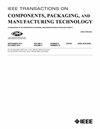Effect of PCB Manufacturing Process Step-Related Cleanliness on Performance of Conformal Coating
IF 3
3区 工程技术
Q2 ENGINEERING, ELECTRICAL & ELECTRONIC
IEEE Transactions on Components, Packaging and Manufacturing Technology
Pub Date : 2025-04-07
DOI:10.1109/TCPMT.2025.3558701
引用次数: 0
Abstract
In the presented work, the accumulative effect of different manufacturing steps of printed circuit board (PCB) on conformal coating performance is evaluated. An interdigitated comb pattern on an FR-4 board was used as a test PCB. Manufacturing processes included base test PCB produced by three different manufacturers (Man) incorporating copper-clad lamination (CCL) and hot air solder leveling (HASL) steps. In addition, test boards underwent typical wave solder and selective mini-wave steps. Commercial co-polymer polyurethane/polyacrylate and urethane acrylate conformal coatings were applied on test boards before as well as after soldering process. The study aims to evaluate induced contamination on the PCB surface after these manufacturing steps and the effect of PCB surface cleanliness on the protection performance of conformal coating under humidity. The results revealed chloride residues prior to soldering on the PCB surface with variations across Man-1 (PCB制造工艺步骤清洁度对保形涂层性能的影响
在本工作中,评估了印刷电路板(PCB)的不同制造步骤对保形涂层性能的累积影响。采用FR-4板上的交叉梳状图案作为测试PCB。制造过程包括由三个不同的制造商(Man)生产的基础测试PCB,包括覆铜层压(CCL)和热空气焊料流平(HASL)步骤。此外,测试板进行了典型的波峰焊和选择性的微波步骤。商用共聚物聚氨酯/聚丙烯酸酯和聚氨酯丙烯酸酯共形涂层应用于测试板焊接前和焊接后。本研究旨在评估这些制造步骤对PCB表面的诱导污染,以及PCB表面清洁度对保形涂层在湿度下防护性能的影响。结果显示,在Man-1 ($0.2~\mu $ g/cm2), Man-2 ($0.4~\mu $ g/cm2)和Man-3 ($0.8~\mu $ g/cm2)之间,PCB表面上焊接前的氯化物残留量存在差异。在湿度暴露下的表面绝缘电阻(SIR)测量中,Man-3显示出100%由枝晶形成引起的故障,其电阻水平始终低于Man-1超过十年,突出了基本PCB材料的质量是湿度相关问题的主要因素。同样重要的是发现不同的波峰焊方法和涂层。然而,最初的污染在随后的制造步骤中占主导地位,根据助焊剂和涂层化学成分的不同,氯化物污染最高,导致长达十年的差异。
本文章由计算机程序翻译,如有差异,请以英文原文为准。
求助全文
约1分钟内获得全文
求助全文
来源期刊

IEEE Transactions on Components, Packaging and Manufacturing Technology
ENGINEERING, MANUFACTURING-ENGINEERING, ELECTRICAL & ELECTRONIC
CiteScore
4.70
自引率
13.60%
发文量
203
审稿时长
3 months
期刊介绍:
IEEE Transactions on Components, Packaging, and Manufacturing Technology publishes research and application articles on modeling, design, building blocks, technical infrastructure, and analysis underpinning electronic, photonic and MEMS packaging, in addition to new developments in passive components, electrical contacts and connectors, thermal management, and device reliability; as well as the manufacture of electronics parts and assemblies, with broad coverage of design, factory modeling, assembly methods, quality, product robustness, and design-for-environment.
 求助内容:
求助内容: 应助结果提醒方式:
应助结果提醒方式:


